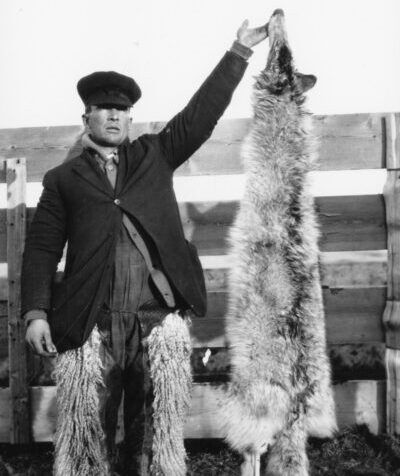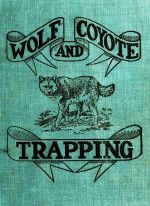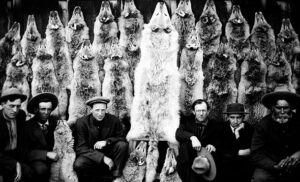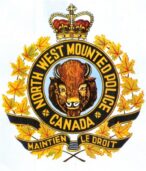What are wolfers?

The Wolf Hunt: Wolfers in the Old West & Canada – History & Today – What are Wolfers?
Wolfers were hunters who specialized in killing wolves. Selling the bloody pelts for the cash bounties paid by US Federal, Western State and Territorial governments — as well as Cattlemen’s Associations.
By the early 1870s, “wolf hunters had almost exterminated every wolf from Texas to the Dakotas, from Missouri to Colorado.” [1]
So they moved into the unpoliced Canadian Northwest.
Wolfers laced the bodies of skinned bison or freshly killed mule deer with strychnine, a cruel poison. Wolfers and Buffalo Hunters often worked together. After buffalo were slaughtered and skinned, the unwanted bodies were left unused and rotting on the prairie. Wolfers would sprinkle the carcasses with their strychnine. The Native peoples were enraged at the mass slaughter of their bison (as well as the resulting strychnine poisoning of their family dogs) and the white hunters would band together for security.
An example of this was the 1870’s fortified fur trading post on the Spitzee River (aka High River) on the Canadian western plains. The group of buffalo hunters, wolfers and fur trappers called themselves the “Spitzee Cavalry.” The “cavalry” attacked both outraged Natives and white whiskey traders who were giving guns and ammunition to the local First Nations.
A US government pamphlet had the following to say about how to poison wolves:
 “Many wolves are killed by poisoning. And more would be so killed if the methods followed were less crude. Strychnine is generally used with nothing to disguise its intense bitterness. The powder being either inserted in bits of meat or fat or merely spread on a fresh carcass…
“Many wolves are killed by poisoning. And more would be so killed if the methods followed were less crude. Strychnine is generally used with nothing to disguise its intense bitterness. The powder being either inserted in bits of meat or fat or merely spread on a fresh carcass…
“In most cases the wolf gets a taste of the bitter drug and rejects it. And if the dose is swallowed it may be too small to be fatal or so large as to act as an emetic…
“An old and experienced wolf will rarely touch bait poisoned in the ordinary way. But sometimes a whole family of young may be killed at a carcass. Usually when wolves are poisoned, they go so far before they die that if found at all it is not until their skins are spoiled…
“To encourage poisoning, it must be possible to secure the skins in good condition. Or at least, to find the animals after they are killed, so that the ranchman may have the satisfaction of knowing that he has accomplished something toward the protection of his stock.” [2]
A more recent article about poisoning wolves said this:
“A carcass laced with a small amount of strychnine, a grainy substance that looked like table salt, could attract and kill several dozen wolves within a short period of time. Before the 1880s, a dead buffalo might hold the poison. After the American bison was gone from the plains, another dead animal would suffice. Some wolf hunters sprinkled a carcass with strychnine in the deep of winter, returning in the spring to find dead wolves sprawled around the poisoned animal.” [3]
As bait animals became scarcer, prairie wolfers went back to steel traps and shooting with firearms.
By the turn of the century, strychnine was also being replaced by dynamite, which the hunters threw into wolf dens. Wiping out the entire den — adults and cubs.
Or live pups could be pulled out of their dens with “a hook, something on the order of a gaff hook such as is used by fishermen.” And then killed.

In “Bulletin 72,” issued by the United States Department of Agriculture, the author, Mr. Vernon Bailey, had the following to say on the subject:
“The actual number of cattle killed by wolves can not be determined. Comparatively few animals are found by cattlemen and hunters, when freshly killed, with wolf tracks around them and with wolf marks on them. Not all of the adult cattle missing from a herd can surely be charged the depredations of wolves, while missing calves may have been taken by wolves, by mountain lions, or by ‘rustlers.'”
And Perry Davis, an Old-time American wolfer, wrote this:
“I have heard of wolves attacking persons in the woods of the Northeastern States. I have no reason to doubt this. They may be a different wolf from our grey wolf, or buffalo wolf, as they are often called. I have seen grey wolves in the Panhandle country of Northwest Texas, in Colorado, Wyoming, the Dakotas, Montana and Canada. They are all the same, as far as I could see, in looks, size and habits. And I have never heard of them molesting anyone in the above mentioned places.”
And…
“There is no authentic report of wolves ever having killed a human being in the Canadian North, although there must have been times when the temptation was well-nigh irresistible.” – Canadian naturalist and author Farley Mowat.
And…
“Books and movies set in the Northern forests abound with scenes of wolf packs savagely attacking humans. Thrilling scenes! But people native to the Northwoods say they don’t personally know of such clashes.” – Brian Alan Burhoe
Wolfers in Canada. An Historic Note:
 Wolfers, along with buffalo hunters and fur trappers, notoriously were among the members of the “Spitzee Cavalry” who attacked a band of sleeping Assiniboines in June of 1873. The Cypress Hills Massacre. [4] The tragic event that led to the formation of the North-West Mounted Police.
Wolfers, along with buffalo hunters and fur trappers, notoriously were among the members of the “Spitzee Cavalry” who attacked a band of sleeping Assiniboines in June of 1873. The Cypress Hills Massacre. [4] The tragic event that led to the formation of the North-West Mounted Police.
For more, see CANADIAN MOUNTIES Creation & History Royal Mounted Police – RCMP News.
Modern Wolfers: What is a Biological Surplus?
Today, of course, wolf hunts are happening again! [5] Especially in Alaska and Canada.
Today we’re hearing it put in ice-cold, scientific terms. Biological Surplus: “The amount of animals in a given population that are above the carrying capacity.” Carrying Capacity: “The number of animals each habitat can support throughout the year.” Nothing cold about about it to the wild wolves. Their deaths are hot and blazing pain.
As for the “number of animals each habitat can support” — before WE arrived, the rich green land was thriving with deer, moose, beaver, wolves and bears. Passenger Pigeons and Great Auks. Queen Charlotte Islands Caribou and Newfoundland Wolves. Ungava Grizzly Bears and Sea Minks. God’s Country in every sense of the words. Then WE came. No wonder we got kicked out of Eden, eh? All that was left was a snake and an apple tree. [6]
CANINE COMMENTARIES:
[1] https://en.wikipedia.org/wiki/Wolfers_(hunting)
[2] From WOLF AND COYOTE TRAPPING: An Up-to-Date Wolf Hunter’s Guide, Giving the Most Successful Methods of Experienced “Wolfers” for Hunting and Trapping These Animals by A. R. Harding, 1909.
[3] https://outsidebozeman.com/nature/killing-fields
[4] A Helena newspaper gave this account of a “party of wolfers, who had been out in the Whoop-up Country during the entire past winter.” The story was based on the eyewitness report of two participants:
“Our agent, just returned from Benton, brings the particulars of a recent fight between the whites and Indians, which terminated as fatally to the latter as did the engagement of Col. Baker and troops with the Piegans three years since…
“Each man was armed with a Henry rifle and two Smith & Wesson’s large revolvers, was well mounted, and five good pack animals were taken along with the party…
“They arrived at a small trading post at Cypress Mountain, two hundred miles within the British border. It was determined to attack this encampment of Assiniboines… ”
– Helena Daily Herald, June 11, 1873.
“Seven Wolfers Arrested for Attacking Canadian Indians”
In December 1874, Writs of Extradition were filed by Superintendent James Macleod of the NWMP against seven American and Canadian wolfers in Helena, Montana Territory. The seven were arrested. Two escaped custody before they could be questioned.
The remaining five wolfers’ stories matched each other’s word by word. They claimed that they were chasing Assiniboine warriors who had stolen horses from them. And that they were fired on first by Indians when they reached Cypress Hills in Canadian territory. “We were defending ourselves.” In turn, Macleod put into evidence signed affidavits by witnesses of the massacre, both White and Native.
When word got out that white men could be taken to Canada and tried for murdering “just Injuns,” things heated up in the streets of Helena.
The Montana Territorial Court ruled “there was not enough clear evidence to prove anything against the accused frontiersmen.” And refused the extradition request, “as there was far too much conflicting testimony.”
Macleod was briefly charged with False Arrest. But allowed to return to British territory.
Today, even Canadian sources will still quote the wolfers’ version of the Massacre, while original American newspaper reports as well as signed affidavits and witness accounts are ignored.
[5] “The great question of the Seventies is shall we make our peace with Nature and begin to make reparations for the damage we have done to our air, to our land, and to our water.” Richard M Nixon
In 1973 President Richard Nixon signed The Endangered Species Act into law. The U.S. Supreme Court called it “the most comprehensive legislation for the preservation of endangered species enacted by any nation.” They were right. President Nixon is still respected around the world for the ESA. Including here in Canada. I don’t have many political heroes. But Richard Nixon is one of ’em. SEE The Environmental Legacy of President Nixon
[6] “Passenger Pigeons and…” The last six animals mentioned here were all slaughtered to extinction by foreign explorers and settlers.

The Wolf Hunt – Wolfers in the Old West & Canada – History & Now
TAGS Buffalo hunters, buffalo wolf, perfect wolf pelt, project wolf hunting, Spitzee Cavalry, the wolf hunt, what are wolfers?













